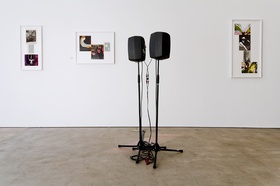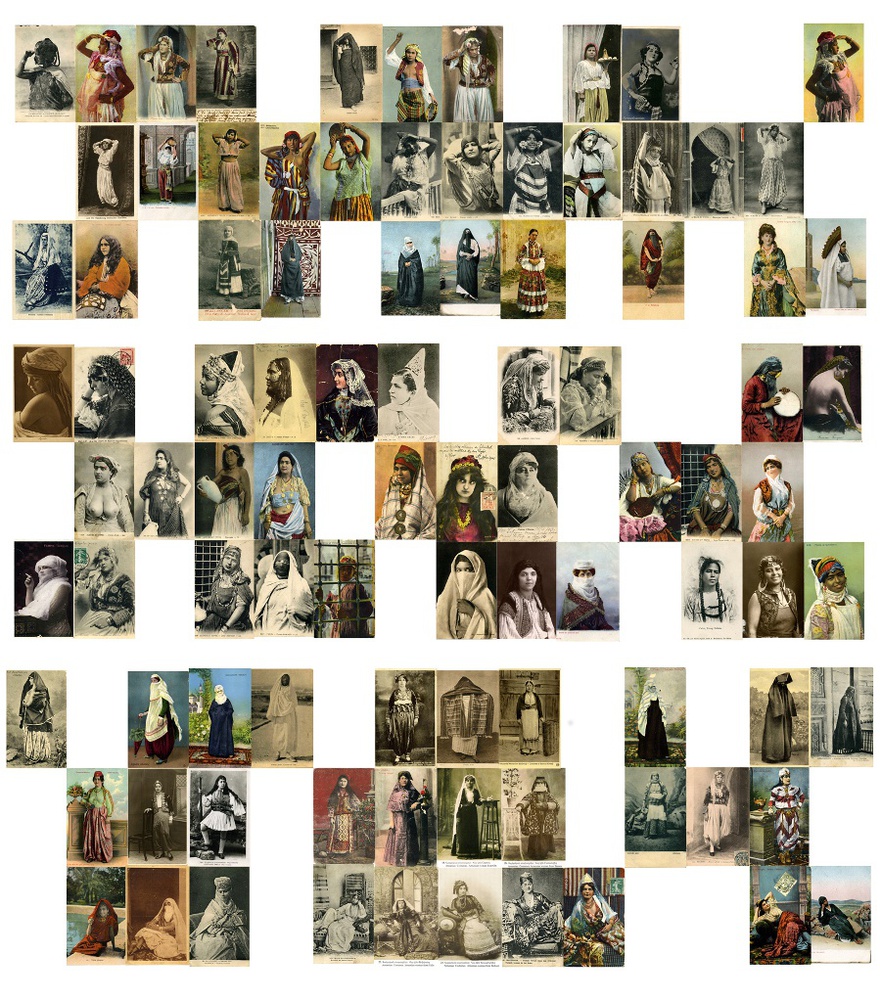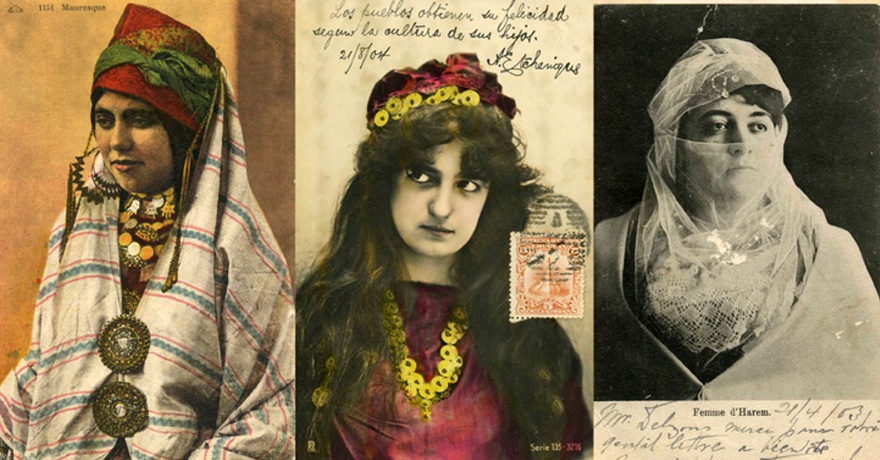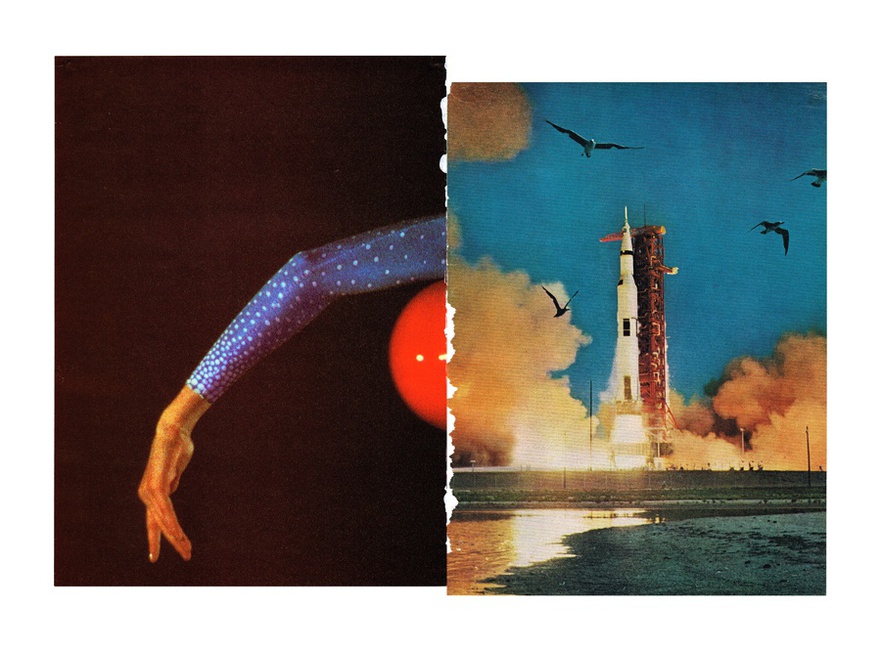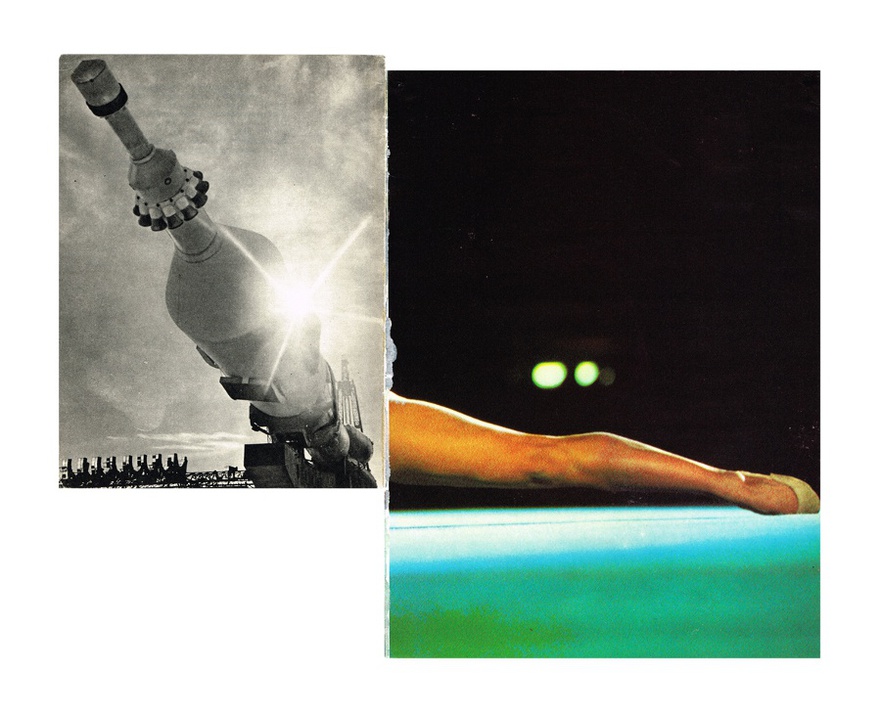Interviews
No Boundaries
Aikaterini Gegisian in conversation with Stephanie Bailey
In this conversation, Aikaterini Gegisian talks about her Ibraaz 008 project it is small, we like it this way, a fictional photo reportage comprised of image fragments found in lifestyle USA magazines of the sixties in articles that focus on the Middle East, North Africa and the Global South. The discussion expands into Gegisian's practice as a whole, exploring the way national and regional identities have been constructed through popular culture, often by those who exist outside the regions in question. From western to eastern imperialism, the Ottoman legacy and the effects of post-colonial recuperation, Gegisian considers what it means to approach the world as a single space within which ideologies and identities overlap and commingle.
Stephanie Bailey: Can you talk about the found images you used for your Platform 008 project it is small, we like it this way?
Aikaterini Gegisian: The images themselves are related to work I have doing with found material since 2011. I began by looking at Soviet photographic albums of Armenia and how modernity was expressed in the Soviet space. More recently, while working on my exhibition, Is this why I cannot tell lies? at Tintype in London in 2014, I shifted my attention from Soviet modernity to American popular culture as depicted in magazines, such as Life and Time. I found them in second hand bookshops and flea markets while I was in New York.
SB: What kind of images were you drawn to in your search?
AG: I started with images of the space race. But while on this search, I came across special instalments, such as 'What went wrong with the Ottoman Empire' in Life magazine. I was also attracted to other images, too, like images that depict how finding oil in the Middle East was represented in popular magazines from the USA. In terms of how I used these images in my Ibraaz project, I didn't want to mark the actual relations posed in the question but I wanted to question the question in itself. I wanted to have a kind of emotional type of response. So I used images to reveal the way in which a colonial image of the Global South or of North Africa has been constructed. Through this, I also wanted to imagine a new way of communicating, or subverting. This has been a very strong direction or focus for me. We are used to a reflective type of practice in postmodernism that reveals the way things are constructed. But there is also a possibility to go beyond the idea that everything is constructed and mediated by repossessing and reusing images to create new narratives for ourselves instead of constantly revealing and making visible the structures of globalization, colonial or imperial structures, or even capitalist structures.
SB: This relates to the exhibition at Tintype you presented in 2014, Is This Why I Cannot Tell Lies?, which conflated images from the former Soviet Union and the United States in the 1960s.
AG: For the exhibition at Tintype, the starting point was moments from a Cold War imaginary in the form of female gymnasts and space rockets, but the conceptual desire was not so much to comment on the similar or differences of the 'East/West' construction but to find a new language for describing female sensibility and sexuality. For example, in the Falling Tight series, images of gymnasts and space missions from both Soviet and USA sources were placed side by side as away of setting against each other two nostalgias: the ideological conflicts of the Cold War and the past of the photographic image. This double mirroring was translated as the double movement of the female body, ascending and descending in space and fluctuating between different poles. In this body of work, I repossessed images imbedded in specific ideologies and historical moments and by taking them out of context and placing them into new associations, I wanted to open up the images to new possibilities and to represent female experience beyond gender polarities.
SB: There seems to be a need today, which you address in your work, to produce more expansive or flexible perspectives, cartographies, or identities. Can you talk about how this expressed itself in the work you showed in Re-Tracing the Land at the New York Art Residency and Studios Foundation (NARS) in 2014?
AG: In the exhibition at NARS Foundation, I presented a selection of collages from the series A little bit too much, A little bit too late (2012–2014). The series is based on images of Soviet Armenia collected from commemorating photo albums and tourist guides. The collages juxtapose archival images of the countryside and the city, with details of dustbins, lampposts, playgrounds, street signs and gas pipes that furnish the contemporary urban landscape of Yerevan. In the gesture of populating archival images with details of the city furnishings that are in a way 'contemporary', I was interested in reimagining a new set of relations that have been obscured or ones that have hardly ever been voiced. In that sense, the remapping in that work was expressed as a challenge to the documentary value of photographic images of the past through the layering of 'inappropriate' symbolic references. I have often described this as a domestication of the image that produces new landscapes that are drenched by the desire to bridge conflicting collective memories and imagine new ways of living together.
SB: How was your approach towards bridging conflicted memories formed? Was there a starting point for you?
AG: More than before, I now allow intuition or my subconscious to lead me. In the case of my Ibraaz 008 project, it started by finding a famous Life cover by accident. The cover features a photograph of rioters as they raise a flag on a street lamp above a burning car at the border between Panama and the Canal Zone, Panama City, Panama, in January 24, 1964. I was drawn to the image around April 2014 when I was talking to Shoair Malvian about the exhibition she co-curated at the Tate Modern Project Space in 2014, A Chronicle of Interventions, which explored the histories of interventions in Central America.
When I came across the image, I started noticing other images of the Middle East or the Global South in the material that I was working with-Life, TIME and Newsweek magazines from the 60s. For example, I found serialisations in the form of three or four instalments about the relations with the Middle East, with titles such as 'The state of the Middle East today'. I was firstly drawn to these particular articles because of the images used, which were images of women from the Middle East in their traditional costume, which I used in a previous work called Self-Portrait as an Ottoman Woman (2012–14). So essentially, what I am describing here is a series of encounters that slowly shaped not only the material but also the conceptual approach of the Ibraaz piece. What I retained from 'The state of the Middle East today' was the form of the serialisations that I also used to present the 3 instalments in the construction of the fictional photo reportage, it is small, we like it this way.
SB: On this idea of remapping, how does the context of Armenia influence your work?
AG: Armenia was Soviet, it was Ottoman, it was Persian – it was all of these things. This already produces a composite set of relations and crossovers between different cultural and geographical spaces. And then there is a diaspora that complicates even further the idea of a stable and fixed notion of 'Armenianness', that in my thinking provides utopic potential. This is, for example, already the premise of the Armenian Pavilion at the 56th Venice Biennale, which brings together contemporary artists from the Armenian diaspora from all these different spaces, that inevitably comments on the production of national identities.
SB: Can you talk about how Self-Portrait as an Ottoman Woman approached this notion of identity production?
AG: The project starts in Yerevan. I went there to make a film about the city because I was fascinated by how Soviet it looked. But the city also represents a very specific symbolic space for people of Armenian origin: the centre of an Armenian state. But there was nothing for me there; there was nothing clear that makes it Armenian. In the trial to understand how this Soviet space could also be part of my own cultural memory, I focussed on the idea of the post-Soviet transition. I started collecting material from Soviet magazines and in this process I questioned the idea of modernity and how even in Soviet modernity we have similar types of narratives as in capitalist modernity, which are narratives of progress and narratives of industrialization. And then in the 1980s, it was obvious in the way that the photo albums were constructed that there was this emerging idea of consumption – consuming culture, consuming urban life.
This research very much shaped my thinking around the idea that photographic images that signify national identity are also images of consumption linked to new popular cultures. In turn, the idea of the production and consumption of photographic images as national signifiers informed the approach in Self-Portrait as an Ottoman Woman. Taking as a starting point the portraits of the heroic workers found in the Soviet Armenian albums, I started collected images of Armenian women in their traditional costumes that reference a pre-modern time, which then expanded to encompass and consider the production of female representations in the post-Ottoman landscape. The photographic albums of Soviet Armenia were the springboard in looking at both the post-Soviet and the post-Ottoman context. And as I was getting deeper in the research, it become clearer how these photo albums, which were produced every 10 years for every Soviet republic, functioned as nation building mechanisms.
SB: Like an almanac?
AG: Yes, and at the same time also as a tourist catalogue and as propaganda: the frame of the photographic albums look at the whole landscape of each Soviet republic. I looked for the same kind of books produced in Turkey, and I found similar in Greece. I also recently found a photo album in New York, titled 'This is Israel' and published in 1949. And there is the infamous one, 'Family of Man', which came out of the exhibition of the same name at MoMA in 1955, with the aim of representing the multifaceted human experience trough the photographic lens. I am mentioning all this because they were steps in identifying a moment in the 1950s and 1960s when photographic practices, especially printed photographs, became the dominant expression of modernity. Photography was used as a tool in representing the idea of and an ideal modern nation. When looking at all these different photographic albums coming out of disperse geographies and ideological contexts, I begun thinking of the connection between different modernist projects and the relationship between colonialism and imperialism.
SB: Before we go there, I want to ask specifically about these books, these photography almanacs that you found. When you found them in Greece and Turkey were they commissioned by the state?
AG: Yes, there are different genealogies. The Turkish photographic albums that I have collected mostly were produced by the state, while others are foreign publications made in the all to known narrative of the explorer discovering the beauties of an exotic land. For Greece, the items I have collected are mainly the official tourist catalogues from EOT (The Greek Tourist Organisation) ranging from 1972 to 1982, so covering the transition from the time of the dictatorship towards the socialist PASOK of the early 80s. Recently, I also found Greek photographic albums of the same period made by French or German publication houses.
SB: And in New York?
AG: In New York it was a different thing because I was using Life and Time magazine, because I think they served the same type of function as the photographic albums in Greece, Turkey and other counties, the function of projecting a sense of a modern dominant nation state. And in the fact that I found this role in Life and Time magazine, it made even clearer in my mind the relationship between nation building process and popular culture.
SB: The construction of national representations in the 50s, 60s and 70s through photography as a dominant expression of modernity makes me think of archaeologists coming into Greece and engaging in a kind of retrospective national identity building through a rediscovery of the classical past in the nineteenth century.
AG: Your comment describes my approach in bringing together images from photographic albums of Greece, Turkey and Soviet Armenia, in order to construct a new imaginary landscape. It also highlights a dilemma, the trail to avoid imposing a retrospective sense of unity. This is a problem of temporalities. Already in the material I have collected, they are different time frames. The earliest Greek photo albums were made in the early twentieth century, while in Turkey the earliest I found were produced in the 50s. I am not a historian, but the I can sense that the different time frames might respond to different stages in the nation building processes of each country.
SB: It's curious because this taps into this tendency for nation building through image and artefact or object: the production of a national image through a whole range of representations contained within a frame or logic, so to speak… (can we please avoid ending with ellipses, it makes the text look like it wasn't edited).
AG: Exactly. And it is interesting while I was in New York, after all of the collection of Soviet Armenian images to finally find a book Days with Ulanova, compiled by the photographer Albert E. Khan and published in USA in 1962, that was a portrait of Soviet life from another perspective. This is even more fascinating when you realise that the photographic texture and print quality is very similar to the photographic albums produced in the Soviet Union.
SB: Something curious about your work is this kind of comparison, or conflation, of the post-Soviet and post-colonial contexts, since you go into the Ottoman but also this post-Soviet legacy, too.
AG: The intention was not to conflate them but my interest was very clearly to explore what this moment of transition – from the Ottoman to post-Ottoman or the Soviet to the post-Soviet. These sorts of narratives are always about the old being replaced by the new, and yet there are all these continuities that are never addressed that say a lot about how modernity and the state functions – these narratives are never sinuous or obvious, they are always complex. There is never a moment of transition.
SB: They are never really resolved, either.
AG: Yes. I wanted to question or reveal this complexity of the idea of transition. The fact that I focus on the post-Soviet and post-Ottoman context is due to my own biography. The post-colonial narratives are usually western-centric: the west colonized and apparently gave modernity to certain kinds of spaces. But in the post-Soviet and post-Ottoman context, these narratives are complicated, since Soviet represented a certain type of modernity, so one cannot simply claim that for example Armenia became modern after the fall of the Soviet Union. And the in the last stages of the Ottoman Empire, although still an imperial space, there was an attempt to implement a progressive modernist narrative. Addressing my own identity and the geographies that define me in my practice is a way of complicating a certain pattern of global relations. It is also about making people aware that there are a lot of ways of being and a lot of histories and that we are continuously fixating on specific types of relations.
SB: Thinking about this constant process of relation, what kind of references you've been working with, if there have been any kind of influences that have helped you think about how to formulate or consider or perceive these relations that you see or how to express them?
AG: Obviously, there is the post-Soviet. While I was researching in Armenia there were some people who equated the idea of being post-Soviet with being post-colonial, but this is is also contested. There are different intellectual discourses within the country that try to unpick this complex relation with the Soviet past (Ruben Avershatyan, Hrach Bayardan). In this consideration, to what extent can we claim that the Soviet space was a colonial space? I did tap into post-colonial theory, but only in order to understand relationships that were not linear.
In the way that the research in Soviet Armenia led me into reading on a specific cultural history, similarly in relation to Self-Portrait as an Ottoman Woman, I looked at how women were presented in Ottoman times and considered the relationship between a post-colonial, post-imperial space and modernity. The interesting thing in researching for Self-Portrait as an Ottoman Woman was the idea that the Ottoman woman as a historical category was hardly addressed in academic literature. It is only in the last year that a book was published, titled A Social History of Late Ottoman Women (edited by Duygu Köksal, Boğaziçi University, Istanbul and Anastasia Falierou, University of Athens).
Turkish historiography didn't consider the idea of the Ottoman woman, since this they were equated with the submissive Ottoman harem. There was an emancipatory, feminist movement coinciding with the formation of the Turkish state so academic research focussed on that. And in the post-Ottoman states nobody looked at Ottoman women, since they were focussed on formulating specific national identities. In the Self-Portrait as an Ottoman Woman, I wasn't simply attempting to construct the idea of the Ottoman woman. I placed women from diverse backgrounds in the same space, in order to talk about a collective female experience that had not been addressed and in the process question what kind of boundaries have been placed on these women. What I am describing here is how each body of work opens up different academic discourses and methodologies, from research on specific cultural histories to post-colonial and feminist thought, and from a spatial to a comparative methodology.
SB: You are also problematizing the label of Ottoman. When I hear you talking about it now 'the Ottoman' almost sounds like 'the modern' – like 'modern man' but instead you have 'Ottoman woman'.
AG: Yes. There are always different viewpoints and to me, it's always about questioning our definitions. At some point, I am embracing the Ottoman as a kind of notion or space, but then I step out of that and return from the position of being Greek, moving on to working from the position of being Armenian. The work has the ability to move between all kinds of viewpoints in terms of how things are framed and how dominant discourses assert certain narratives or definitions.
SB: This also enables you to take the various positions and perspectives that you have within yourself. So you can look at it from a Greek perspective or an Armenian perspective, which I think is super interesting because this goes back to mediation as a necessity – you are neither one nor the other.
AG: Yes, you can be all of them at the same time.
SB: Do you think that this is something that has driven you and pushed your work: the question of how to mediate that complex position?
AG: Yes. What has pushed the work is that I am always marginal on all different levels. A minority. In Greece, I am a minority because I am half-Armenian. For me, it was very difficult to understand that I am not totally Greek, which is strange because I was born there. But then I'm not totally Armenian, either. And then I'm also a woman: another type of 'other'. On a personal level, this has been very difficult to navigate, but on an artistic level it has given me the potential and the possibility to explore things from positions and viewpoints that you wouldn't necessarily take. This has pushed me into different spaces and into a certain type of critical position. This is where Deleuze has been very influential in my practice in the last few years: the idea that the position of becoming or becoming something else is always starts from the position of becoming minoritarian.
SB: You're always at the edge of becoming.
AG: Yes. But the position you take is from the margins rather than from the centre. What I tried to express in my Ibraaz Platform 008 response is that there is actually real joy and potential in the fact that we are marginal, or that we have been the periphery or that we have been the 'other'. From that position we can reimagine ways of being that are about being together.
SB: This reminds me of how you assert that as much as there has been a history of western imperialism, there has also been eastern imperialisms as well: you destabilize the extremities of the binary by revealing multiple sides, views and contexts. One of the problems that the 008 platform highlights, and Walter Mignolo talks about this to a certain degree is how the Global South needs to be claimed, in a sense.
AG: Yes, we are already placed in categories, which are not ours. How can we then map the relationships between these different territories – as categories, when these categories are not ours, when somebody else constructed them for us? In the narrative of my Platform 008 project, therefore, I tried to say: let's forget about these categories, forget about the way we have been constructed and find a way of being together or acknowledge that we are here and we are here together.
SB: This approach is problematic in terms of the question of history, though: especially in a region where history is so important.
AG: I am not someone who doesn't address history or who doesn't acknowledge or understand how images frame historical memory. For me, this was a very specific viewpoint. I start with the archive but then I end up in the archive so the work never loses the relation to specific historic moments.
SB: But you are also subverting the way these historic moments are constructed in popular culture, as a kind of nationalist propaganda, which makes me think of this this post-national, neo-national edge that we are teetering on right now in the world. It's a kind of head-butting stalemate…
AG: I know. I am very interested to see what will happen when I go back to Greece, because there seems to be a polarisation between the post-national and this extreme nationalism. Both sides are pushing the other towards opposite edges of the spectrum and it seems like we will end up with strong polarization not only within countries but also globally.
SB: I'm curious: if you think about the surface and the meta-narrative being this national/post-national moment, then where do we go after post-modernism?
AG: I'm not satisfied with the idea of post-modernism because you are fragmented so much that there is nothing, no integrity in the end, and I am not very satisfied with the post-colonial context either because we are always discussing this relationship between centre and periphery.
SB: This assertion that post-modernism doesn't work might explain the polarization we are witnessing today, in that people are reaffirm or asserting boundaries.
AG: Yes, it does actually. We are continuously using the theoretical concepts which are informed or driven out of capitalist structures so I think, in a way, post-modernism was convenient because it described a moment of capitalist development and the same with post-colonialism. And I think we need to start thinking of formulating ways of thinking that are not so much trying to understand capitalist structures but trying to reimagine new ways of being. I know it's a very utopic space. But I feel that it is within all our practices as well, within academic discourses, within critical art practices, there is a continuous effort, a really laboured effort, to try to reveal the structures of capitalism, which is the colonial structure, if you can conflate these two. We are spending so much time and energy revealing and revealing how capitalism functions only to end up providing new ideas for consumption. This is an on going concern, something that I hope I can solve through the kind of images I create. I hope we can try and find other ways of thinking. And in my view images when they become autonomous from ideological positions, they hold a radical potential for thought.
Follow this link to view Gegisian's 008 project, it is small, we like it this way.
Aikaterini Gegisian is a Greek visual artist of Armenian descent living and working in London. In 2014 she completed a PhD at the University of Westminster, London, and is currently Visiting Scholar-Artist at the University of Pennsylvania, USA. She has participated in international residencies such as Alanica 2013, North Ossetia, Russia; Utopiana, Yerevan, Armenia; ARC Residencies, Cairo, Egypt; Partage Residencies, Mauritius and PIST, Istanbul, Turkey. Recent solo shows include Who Doesn't Like a Good Old Story?, Kalfayan Galleries, Athens, Greece (2012); Diego Garcia, Centre of Contemporary Art, Thessaloniki, Greece (2011), and Picture This, Atelier Space, Bristol, UK (2011).

